Graptopetalum paraguayense peach is a versatile, fabulous plant. Common names of these plants are ghost plant, mother of pearl plant.
They are quite famous for their blue green colored leaves which usually tend to have a touch of lavender, pink and blue pastels.
If you wish to start growing one of these amazing looking ghost plants, keep reading this article since I am going to cover their growing conditions, propagation methods, special care tips etc. A
s you read this article you will understand how easy it is to care for them.
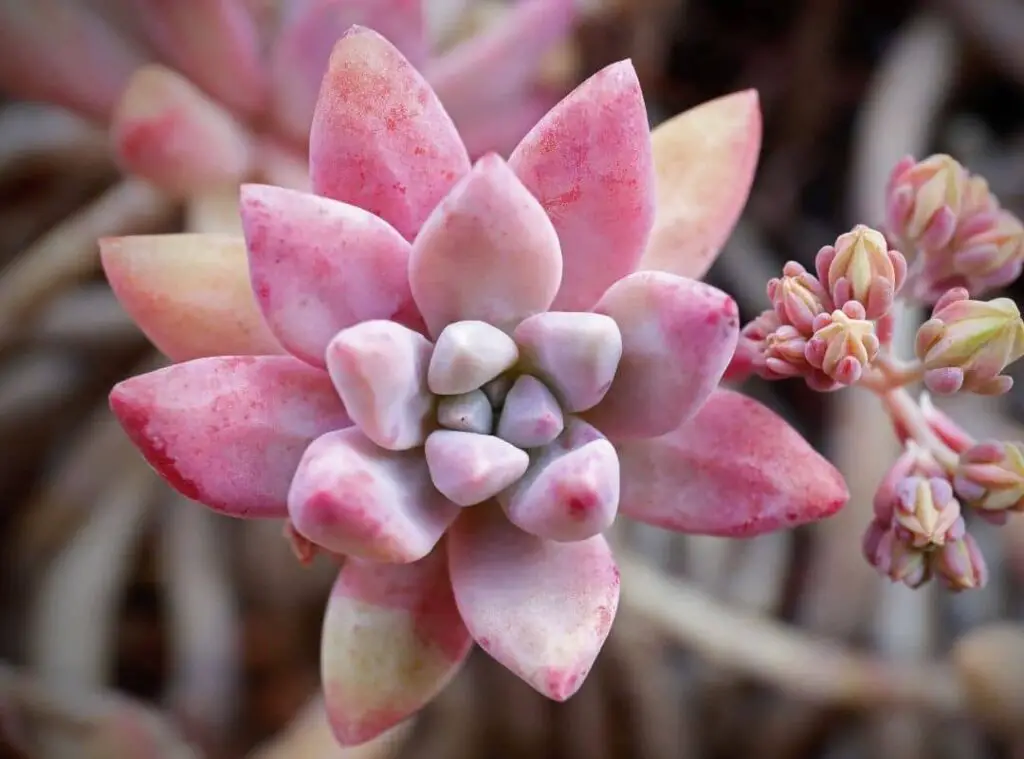
How do I identify Graptopetalum paraguayense peach?
You may identify the Graptopetalum paraguayense peach by looking at their leaves first. They are thick and fleshy to the touch.
Further their stem is also thick and fleshy to the touch. They Are useful to conserve water and that consequently help them to thrive longer periods without water.
Further their foliage could be spotted in silvery gray, blue green colors.
Moreover, chances are that they will have pinkish tinges on their margins of the leaves, particularly when they are in their young stage.
Ghost plant leaves form in rosette types. Those leaf widths could be ranging from 2.5 cm – 7.5 cm.
Graptopetalum paraguayense peach resembles an Echeveria plant which is yet another common and attractive plant. Once you expose them to bright sunlight, they tend to change their colors.
Once you let these plants grow in full to partial shade, that will allow the plants to come up with blue gray tones.
On the other hand, if you keep these plants full of sunlight, that will make the plant look in yellow, pink colors.
Further they will become somewhat translucent too. Moreover when you expose them for heat, chances are that they will turn gray along with pink touches.
In addition to that you could identify them from their flowering activity also. They usually produce airy flowers in yellow during spring and in summer.
Size
Rosettes would be about 4 inches (10cm) in width.Graptopetalum paraguayense Plant will grow up to 1 foot (30 cm) in height. Moreover, they could trail up to 3 feet (91 cm) in length too.
Growth
They usually tend to show a slow to moderate growth rate
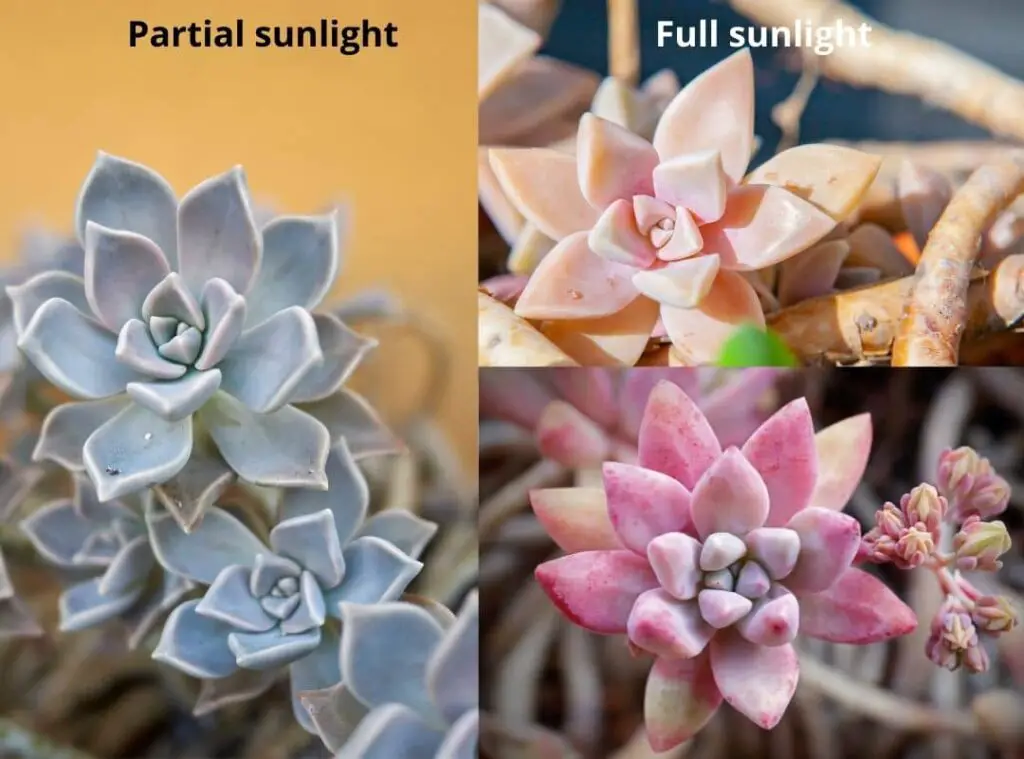
One look care guide
| Botanical Name | Graptopetalum paraguayense |
| Common Name | Ghost plant, mother of pearl plant |
| Plant Type | Perennial succulent |
| Mature Size | Rosettes grow up to 4″ (10 cm) widePlant can grow to 1 foot (30 cm) and trail up to 3 feet (91 cm) long |
| Sun Exposure | Full sunlight to partial sunlight |
| Soil Type | Well-draining sandy and light soil mix |
| Soil pH | 6.1-7.8 |
| Bloom Time | summer and in spring. |
| Flower Color | white and yellow |
| Hardiness Zones | Zone 9a (Minimum 20° F | -6° C) |
| Native Area | Mexico |
| Toxicity | Nontoxic |
| Average price | 10 USD |
14 Ways to care for Graptopetalum paraguayense peach
Light Requirement
When you grow the Ghost plants, undoubtedly you need to select the brightest sunny spot at your home.
It could possibly be the brightest sunny window at your home. If you think it still lacks enough sunlight, you may consider bringing the plant out a few times and then bringing them in.
It is important that you expose them for bright sunlight since that will allow the plants to become more vivid in their colors.
In addition to that, Graptopetalum paraguayense peach tend to become etiolated when they lack adequate sunlight.
You need to be mindful when you are growing them indoors and to provide sufficient sunlight since they cannot withstand poor sunlight for longer periods.
However, you could be tactful in placing a grow light near these plants since that will allow the plants to grow vigorously.
Grow lights are useful to supplement them with extra light particularly during long dark winter times.
When you grow the Graptopetalum paraguayense peach as outdoor plants, the best is to grow them in a place where they can gain bright sunlight to partial shade.
Ghost plants can bear full sunlight. However, it is important that you slowly acclimate them to full sunlight.
If you expose them to full sunlight at once, it could make the plants traumatize. Further if you expose them for brighter sunlight, their colors will become more vibrant.
You do not have to worry about exposing them to intense sunlight since they have a powdery waxy coating layer on the leaves.
Having said that, if you expose them to extreme heat waves, that will create sunburns in the plant.
Temperature and humidity
Hot weather conditions perfectly suit these plants. Having said that they cannot withstand the excess humidity levels though.
Particularly if you let them grow in poor draining soil.further , if you have grown them in raised beds, you may grow them away from each other. That will help to have better air circulation.
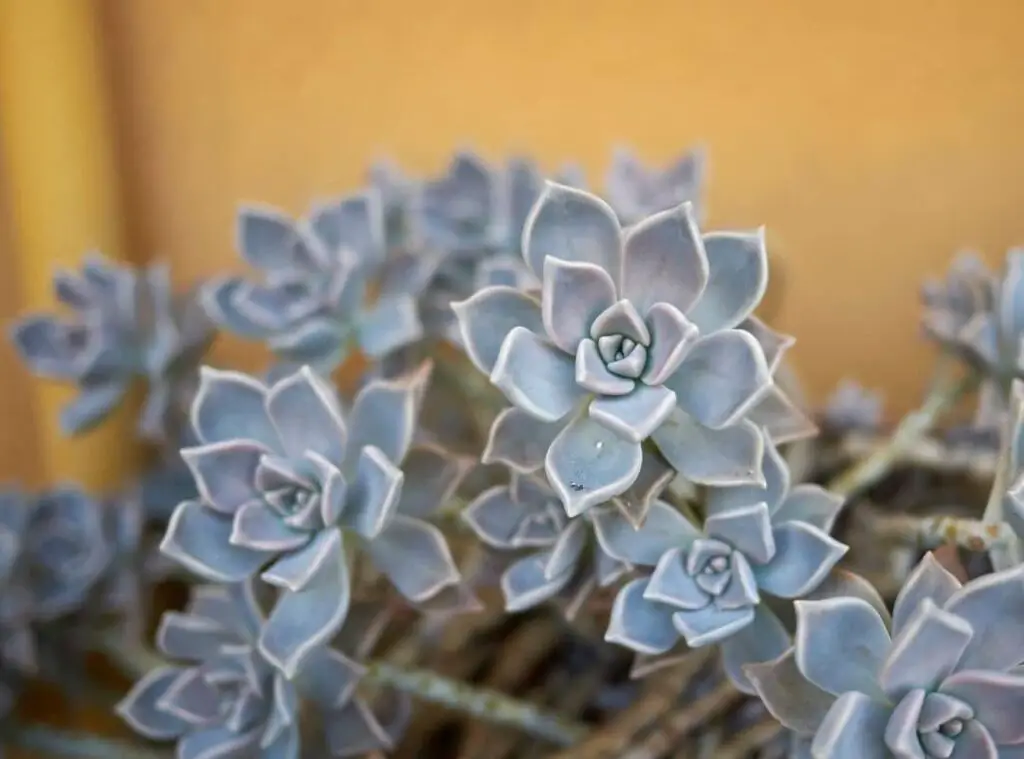
Is it cold hardy?
Graptopetalum paraguayense peach are tolerant of mild frost conditions and slight freezing temperatures. They are frost hardy up to 10-20 degrees Fahrenheit (6-12 degrees Celsius).
Having said that, you need to protect the plants from sudden drops in temperatures.
As such if you live in colder areas, you need to grow them in containers which you could easily relocate them in and out from your house.
If you find it difficult to bring them in and out from your house, you could protect the plants from covering them with frost clothes.
Alternatively, you may keep them in mini greenhouses also.
Hardiness Zone
Graptopetalum paraguayense peach are hardy in USDA hardiness zone 9a (Minimum 20 degrees Fahrenheit /-6 degrees Celsius).
Watering Requirement
It is vital that you water them properly as it would have a greater impact on keeping the plant healthy. Graptopetalum paraguayense peach are used to grow in hot and dry weather conditions.
However, you still need to supply them with adequate water.
You need to adjust the watering frequency depending on the seasons you are passing In seasons like summer, you may water them once every 10 days.
On the other hand, when you water them in colder conditions, you could water them once every fortnight. Further you may skip watering them during winter and let them depend on winter rain only.
If the plants do not get rain only, you need to consider watering them once every month. If you live in high humidity levels, avoid over watering them since that would be the biggest mistake you make when taking care of them.
If the plant lacks sufficient sunlight and if it gets too much water, they will have severe repercussions to the health of the plant.
The best way of watering them is to observe the moisture of the soil before you commence watering them.
In case you are still unsure, I recommend waiting for some more days and only then water. Keep In mind it is always best to underwater them rather than over watering them.
On the other hand, you need to always check the plant to spot if there are any signs of under watering or over watering.
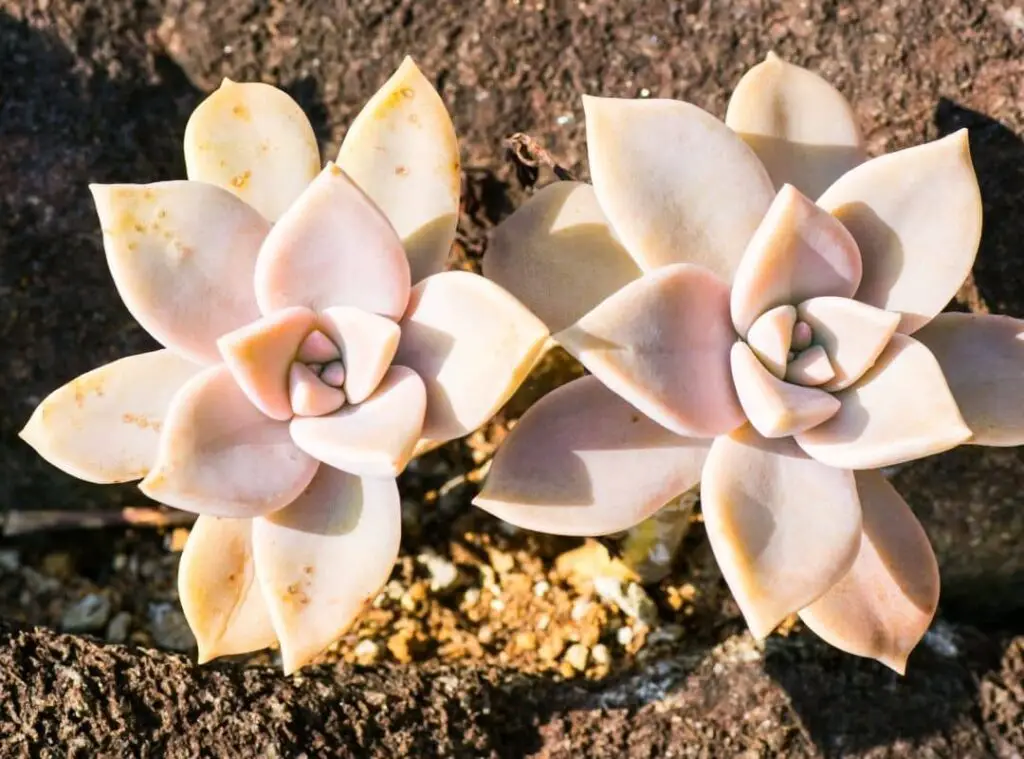
Soil Requirement Type / pH
Graptopetalum paraguayense peach would also perform well if they were given a soil mix which is free draining. If you wish to go ahead with a right soil mix, you could use a cactus potting mix along with perlite.
The purpose of adding perlite is to fasten the draining of the soil mix. You should blend them at a ratio of 2:1. (cactus soil mix to perlite).
You blend them at a ratio of 1:1 if you live in high humidity levels.
Alternatively, you could make a sandy soil which could also fasten the drainage of the potting medium.
To do that you may mix cactus soil mix or potting soil mixed along with coarse sand at a ratio of 2:1. Furthermore, you may make another mix along with cactus mix perlite and coarse sand at a ratio of 1:1:1.
Flowering and Fragrance
Graptopetalum paraguayense peach form flowers in white or in yellow. Further they tend to take a star shape. It would be very eye-catching to watch them in full blossom since they would look fantastic along with pastels.
Their flowering season would fall in summer and in spring. Further chances are that there could be certain Graptopetalum paraguayense peach which would not flower. That will depend on the environmental conditions also.
Pot size Potting and Repotting
When it comes to selecting the right pot size, the best is to go ahead with a pot which is slightly larger than your plant.
Further you may grow them in clay pots or in terracotta pots as they do not retain excess moisture within the pot.You do not need to repot them frequently.
You could consider repotting them when they outgrow them from the pots. Further , when you repot them ensure that you handle the entire process smoothly without injuring the plant.
You need to be mindful of the powdery coating of the leaves especially as they are so delicate.
Further when you grasp the plant ensure that you are grasping it from the crown of the plants and not from its leaves. After that you could transplant them in a fresh slight potting medium.
Where to Plant
You could plant them in an area where they expose for full sunlight. Further when you grow them indoors, make sure you are growing them in a well-draining soil mix.
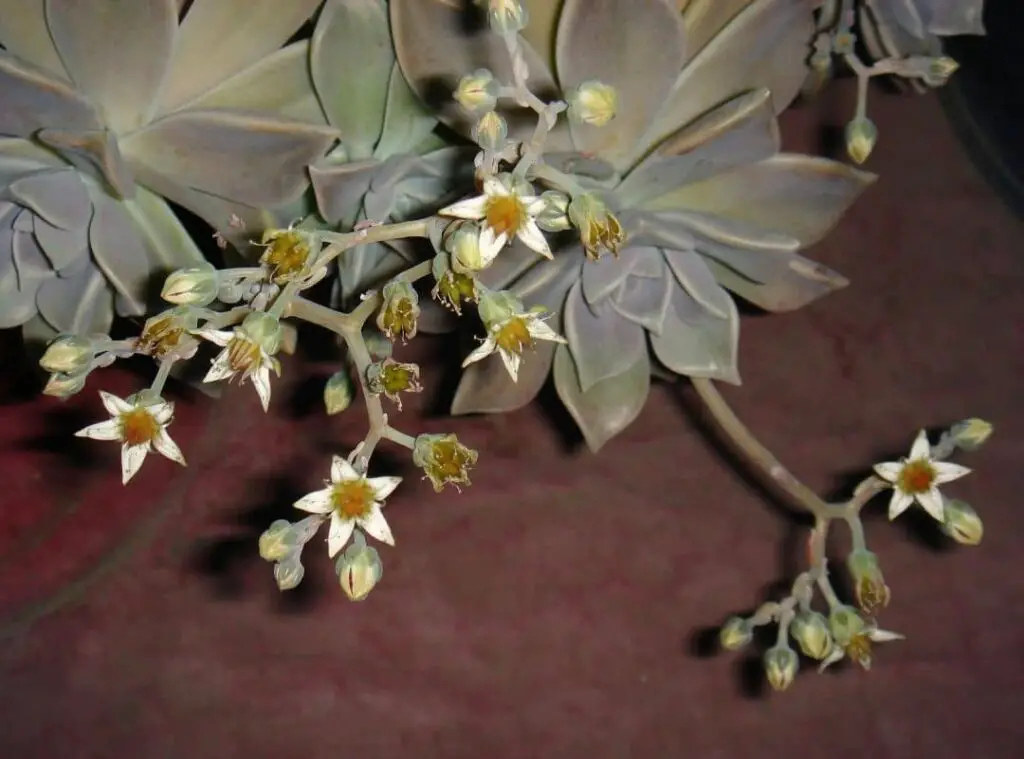
Fertilizer and time of year
Fertilizing the Graptopetalum paraguayense peach is not mandatory to do. Having said that, extra nutrients will give that extra stimulation for the plants to grow vigorously.
Further it will stimulate blooming activity too. you could apply fertilizers during spring or in summer.
Further when you feed them make sure you are doing at a quarter or half strength. In terms of frequency, you could feed them once every fortnight.
Skip feeding them particularly during the latter part of the fall and during winter. You may use a diluted balanced fertilizer when feeding them.
Dormancy
Graptopetalum paraguayense peach are semi-dormant during winter.
Can be toxic to pets
Graptopetalum paraguayense peach are not toxic for pets generally.
As such you do not need to have second thoughts of growing them indoors even if you have pets at your home.
Common bugs and illnesses
Graptopetalum paraguayense peach may come across pests’ attacks such as mealybugs.
It is important that you take off the dead leaves particularly at the base of the plants unless those could be perfect breeding places for bugs and pests.
If you find any mealybugs, the best is to treat them with isopropyl alcohol. Alternatively, you may use nee oil as well.
In addition to above, the faults you make when watering them could cause root rot.
That is why it is crucial that you water them properly so that it would not lead to over watering which could create such a root rot.
Further it would make the plants more prone for other diseases.
Special Care tips
You may consider pruning them when they become leggy and etiolated. Further ensure that you are keeping the surrounding of the plant tidy and neat too.
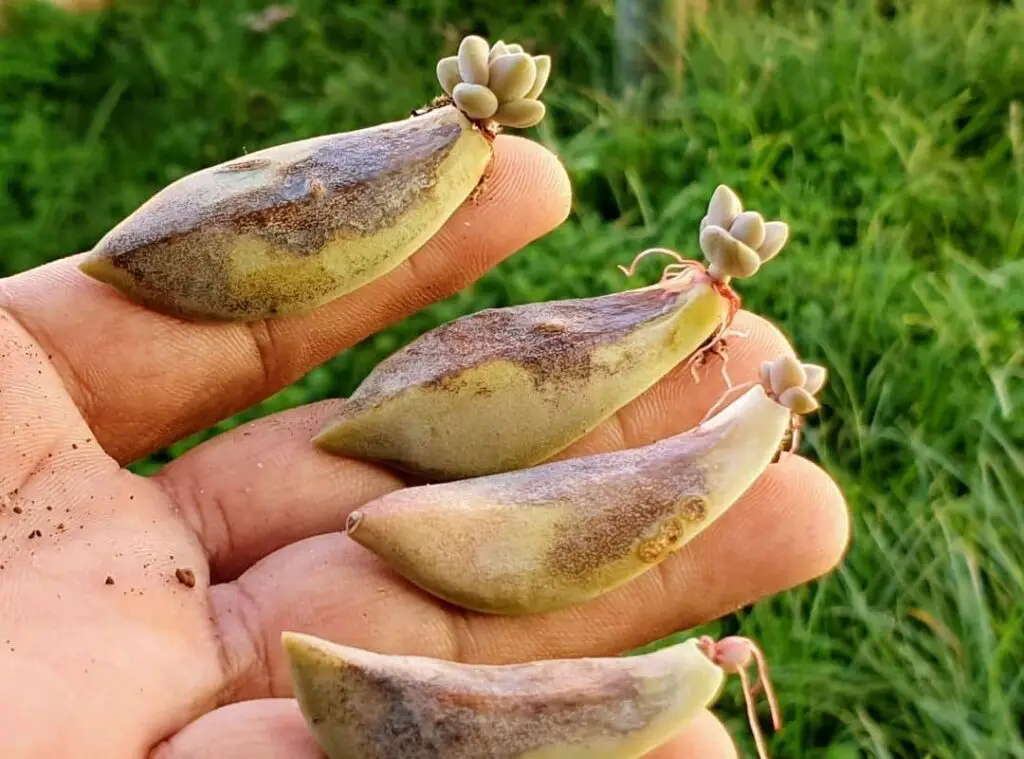
How to propagate Graptopetalum paraguayense peach.
Propagating the ghost plants is a very easy process. Stem cuttings to propagate them is the easiest way of doing.
However, using leaf cuttings is also easy to propagate Graptopetalum paraguayense peach . However, it will be more time consuming when you use the leaf cutting method to propagate them.
Further you can always rely on the results of the stem cutting propagation method. Hence best is to do the stem cutting propagation method.
Propagating by stem cuttings
- First you need to obtain a stem cutting and let them dry for a couple of days.
- During this time, it will allow them to develop callousness.
- Further when you obtain the cuttings ensure that you are obtaining them from a plant which seems to be healthy. Avoid using cuttings from dehydrated plants.
- If you wish you may dip the cut edges in a rooting hormone. It is not mandatory to do so.
- However, many people tend to do this to stimulate the propagation process and to have reliable results.
- When the cut edges develop callous you may place them in a well-draining soil mix.
- Avoid exposing the specimen for direct sunlight and water them once every few days whenever you spot the soil is dry.
- You could spot them forming roots within two weeks’ time and it will take another four more weeks to complete the rooting process and to form the new growth.
- When they have completed forming roots you could continue with the regular care treatments with the plants.
Propagating the ghost plants by Leaves
- To start off this, you need to first take off a leaf gently from the plant. When you remove the leaf from the plant make sure you are obtaining the whole leaf and there are no leftovers on the stem.
- You may gently twist them off from the plant to remove them. Further ensure you are taking a leaf which is healthy and plump for this process.
- You could dip the cut ends in a rooting hormone if you wish to do so. However It would be useful to speed up the rooting process particularly when you are using the leaves to propagate them.
- After that you need to wait for a couple of days and leave them in a dry place without exposing them to direct sunlight though.
- Next you may plant them in a well-draining potting mix. When they are dry, you may place them in the soil.
- It will take about two weeks to start forming the roots. Further it will take a few more weeks to form new baby plants.
- In addition to that, you may use their seeds to make new plants too. You simply have to collect the seeds from seed pods or purchase them from stores and then sew them on a sterilized potting mix.
- You may water them lightly. Moreover make sure you keep the tray in a location where they can gain bright sunlight and, in a temperature, around 70 degrees Fahrenheit.
- It will take about three weeks for the germination to take place.
Graptopetalum paraguayense peach plant benefits
Ghost plants would be great as beautiful houseplants.
You could grow them in cute looking containers, and they will undoubtedly turn out to be fabulous plants which will grace the entire set up.
Ghost plants are great picks for rock gardens as well.
Conclusion
Trust this article was helpful for you to enhance your knowledge on growing the Ghost plant well.
Many people tend to grow the ghost plant due to its pastel colors and due to their ability to form in a spilling manner.
Their stems form in a sprawling manner. Moreover as they grow, they tend to grow whilst spilling out from the container.
Ghost plants are originally from Mexico, and they are endemic plants there. These are in fact a set of perennial succulents.
Finally we hope you are now well aware of their right growing conditions as well as how to propagate them successfully too.
As you may already understand, Ghost plants are such an attractive set of plants which would reward you with flourishing plants in return if you took care of them well.
Read Next: Aloe Pink Blush Care And Propagation| 15 Important Care Tips |
